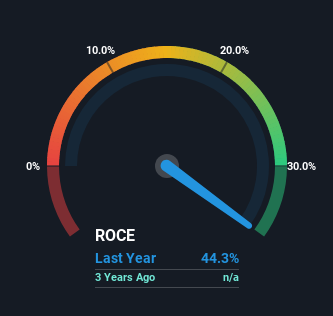- India
- /
- Metals and Mining
- /
- NSEI:JAIBALAJI
Returns on Capital Paint A Bright Future For Jai Balaji Industries (NSE:JAIBALAJI)
If we want to find a stock that could multiply over the long term, what are the underlying trends we should look for? One common approach is to try and find a company with returns on capital employed (ROCE) that are increasing, in conjunction with a growing amount of capital employed. Ultimately, this demonstrates that it's a business that is reinvesting profits at increasing rates of return. Speaking of which, we noticed some great changes in Jai Balaji Industries' (NSE:JAIBALAJI) returns on capital, so let's have a look.
What Is Return On Capital Employed (ROCE)?
For those that aren't sure what ROCE is, it measures the amount of pre-tax profits a company can generate from the capital employed in its business. The formula for this calculation on Jai Balaji Industries is:
Return on Capital Employed = Earnings Before Interest and Tax (EBIT) ÷ (Total Assets - Current Liabilities)
0.44 = ₹8.2b ÷ (₹34b - ₹15b) (Based on the trailing twelve months to March 2024).
Therefore, Jai Balaji Industries has an ROCE of 44%. In absolute terms that's a great return and it's even better than the Metals and Mining industry average of 14%.
Check out our latest analysis for Jai Balaji Industries

While the past is not representative of the future, it can be helpful to know how a company has performed historically, which is why we have this chart above. If you'd like to look at how Jai Balaji Industries has performed in the past in other metrics, you can view this free graph of Jai Balaji Industries' past earnings, revenue and cash flow.
How Are Returns Trending?
The fact that Jai Balaji Industries is now generating some pre-tax profits from its prior investments is very encouraging. The company was generating losses five years ago, but now it's earning 44% which is a sight for sore eyes. And unsurprisingly, like most companies trying to break into the black, Jai Balaji Industries is utilizing 5,363% more capital than it was five years ago. This can tell us that the company has plenty of reinvestment opportunities that are able to generate higher returns.
On a related note, the company's ratio of current liabilities to total assets has decreased to 45%, which basically reduces it's funding from the likes of short-term creditors or suppliers. Therefore we can rest assured that the growth in ROCE is a result of the business' fundamental improvements, rather than a cooking class featuring this company's books. However, current liabilities are still at a pretty high level, so just be aware that this can bring with it some risks.
The Key Takeaway
To the delight of most shareholders, Jai Balaji Industries has now broken into profitability. Since the stock has returned a staggering 3,139% to shareholders over the last five years, it looks like investors are recognizing these changes. In light of that, we think it's worth looking further into this stock because if Jai Balaji Industries can keep these trends up, it could have a bright future ahead.
If you'd like to know more about Jai Balaji Industries, we've spotted 2 warning signs, and 1 of them is concerning.
If you want to search for more stocks that have been earning high returns, check out this free list of stocks with solid balance sheets that are also earning high returns on equity.
New: Manage All Your Stock Portfolios in One Place
We've created the ultimate portfolio companion for stock investors, and it's free.
• Connect an unlimited number of Portfolios and see your total in one currency
• Be alerted to new Warning Signs or Risks via email or mobile
• Track the Fair Value of your stocks
Have feedback on this article? Concerned about the content? Get in touch with us directly. Alternatively, email editorial-team (at) simplywallst.com.
This article by Simply Wall St is general in nature. We provide commentary based on historical data and analyst forecasts only using an unbiased methodology and our articles are not intended to be financial advice. It does not constitute a recommendation to buy or sell any stock, and does not take account of your objectives, or your financial situation. We aim to bring you long-term focused analysis driven by fundamental data. Note that our analysis may not factor in the latest price-sensitive company announcements or qualitative material. Simply Wall St has no position in any stocks mentioned.
About NSEI:JAIBALAJI
Jai Balaji Industries
Manufactures and markets iron and steel products primarily in India.
Flawless balance sheet and slightly overvalued.
Similar Companies
Market Insights
Weekly Picks


Crazy Undervalued 42 Baggers Silver Play (Active & Running Mine)


Fiducian: Compliance Clouds or Value Opportunity?

Willamette Valley Vineyards (WVVI): Not-So-Great Value
Recently Updated Narratives


The "Molecular Pencil": Why Beam's Technology is Built to Win


ADNOC Gas future shines with a 21.4% revenue surge

Watch Pulse Seismic Outperform with 13.6% Revenue Growth in the Coming Years
Popular Narratives


MicroVision will explode future revenue by 380.37% with a vision towards success


NVDA: Expanding AI Demand Will Drive Major Data Center Investments Through 2026





